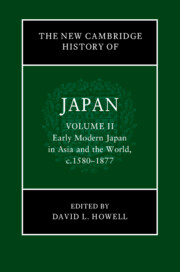Book contents
- The New Cambridge History of Japan
- The New Cambridge History of Japan
- The New Cambridge History of Japan
- Copyright page
- Contents
- Figures
- Maps
- Tables
- Contributors to Volume II
- Preface
- Frontispiece
- Introduction
- Part I The Character of the Early Modern State
- 1 The End of Civil War and the Formation of the Early Modern State in Japan
- 2 Politics and Political Thought in the Mature Early Modern State in Japan, 1650–1830
- 3 Regional Authority during the Tokugawa Period
- 4 Tokugawa Philosophy
- 5 Foreign Relations and Coastal Defense under the Mature Tokugawa Regime
- 6 The Meiji Restoration
- PART II Economy, Environment, and Technology
- Part III Social Practices and Cultures of Early Modern Japan
- Index
- References
5 - Foreign Relations and Coastal Defense under the Mature Tokugawa Regime
from Part I - The Character of the Early Modern State
Published online by Cambridge University Press: 15 January 2024
- The New Cambridge History of Japan
- The New Cambridge History of Japan
- The New Cambridge History of Japan
- Copyright page
- Contents
- Figures
- Maps
- Tables
- Contributors to Volume II
- Preface
- Frontispiece
- Introduction
- Part I The Character of the Early Modern State
- 1 The End of Civil War and the Formation of the Early Modern State in Japan
- 2 Politics and Political Thought in the Mature Early Modern State in Japan, 1650–1830
- 3 Regional Authority during the Tokugawa Period
- 4 Tokugawa Philosophy
- 5 Foreign Relations and Coastal Defense under the Mature Tokugawa Regime
- 6 The Meiji Restoration
- PART II Economy, Environment, and Technology
- Part III Social Practices and Cultures of Early Modern Japan
- Index
- References
Summary
This chapter outlines how from the late seventeenth to the early nineteenth century a mature Tokugawa shogunate recast the Japanese realm’s structures of trade, diplomacy, and maritime defense. It details the ways in which the Tokugawa regime, despite being Japan’s central authority, could not act unilaterally but had to recognize the agency held by the Satsuma and Tsushima domains in their relations with foreign states. In addition, the chapter explains the monopolistic and market tools employed by the shogunate to control key sectors of Japan’s foreign trade. It also explores the broader Pacific contexts – notably a common desire among participants to limit the use of silver in trade with China – that shaped the Japanese state’s foreign trade. Finally, it details the diversity in imported products that emerged by the early nineteenth century, reflected in the variety of goods in demand by both male and female Japanese consumers.
Keywords
- Type
- Chapter
- Information
- The New Cambridge History of Japan , pp. 159 - 183Publisher: Cambridge University PressPrint publication year: 2023



